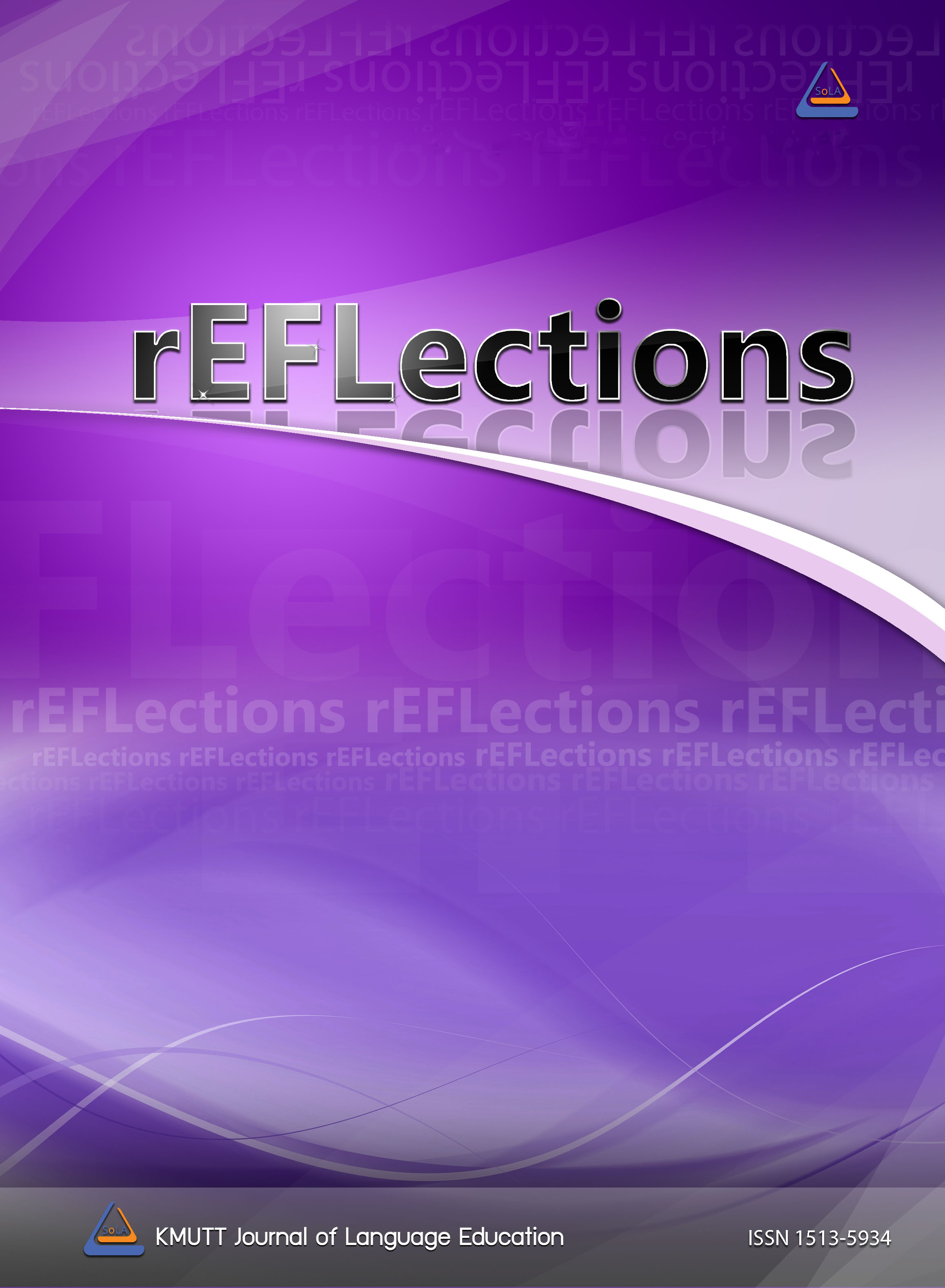In Love and English: A Case of An Extracurricular Activity Conducted in Thailand’s Tertiary Level
Main Article Content
Abstract
In Thailand, in-class teaching and learning are regarded as the principal form of obtaining English proficiency in all skills including listening, speaking, reading, and writing. However, Thai students are still deficient of the ability to effectively wield the skills in real life. This reflects the inadequacy of the classroom teaching of the language and its lack of practical advantage. Therefore, extracurricular activities have been implemented alongside classroom teaching to enhance learners’ ability to use the language in an authentic context as well as their confidence and self-esteem. Chulalongkorn University in Thailand offers students with a variety of out-of-class activities by making it a requirement that first-year students participate in any of them as they are embedded as part of the score collection. One of them is entitled “Love Guru” which allows students from all faculties and majors to participate in. It is organized three times per semester and has mostly received positive feedbacks so far from students as a novel alternative to learn English which additionally serves to bond them together, boost their self-esteem, and encourage them to use English as a means of discussion about the issues that they can identify with. This article elaborates on the characteristics, implementations and results of the activity based on the teacher’s experiences.
Article Details

This work is licensed under a Creative Commons Attribution-NonCommercial-NoDerivatives 4.0 International License.
References
Albayrak, H., & Sener, T. (2021). The relationship between participation in extracurricular activities and motivation of foreign language learning. International Journal of Psychology and Educational Studies, 8(2), 122–132. https://doi.org/10.52380/ijpes.2021.8.2.390
Bacon, C. K., & Kim, S. Y. (2018). “English is my only weapon”: Neoliberal language ideologies and youth metadis course in South Korea. Linguistics and Education, 48, 10-21. https://doi.org/10.1016/j.linged.2018.09.002
Brown, D. H. (2000). Principles of language learning and teaching (4th ed.). Addison Wesley Longman, Inc.
Ellis, G. (2004). Motivating pupils to read. British Council Teaching English. http://www.teachingenglish.org.uk/think/literature/motivate_read1.shtml
Fattash, M. (2008). Investigating the students’ attitude towards using extracurricular activities to enhance their motivation at the English Department An-Najah University. Retrieved from https://www.researchgate.net/publication/275518100_Investigating_the_Students’_Attitude_towards_Using_Extracurricular_Activities_
to_Enhance
Fredricks, J. A., & Eccles, J. S. (2006). Extracurricular involvement and adolescent adjustment: Impact of duration, number of activities, and breadth of participation. Applied Developmental Science, 10, 132–146. https://doi.org/10.1207/s1532480xads1003_3
Gardner, R. C. (1985). Social psychology and second language learning: The role of attitudes motivation. Edward Arnold.
Gardner, R. C., & Lambert, W. E. (1972). Attitudes and motivation in second-language learning. Newbury House Publishers. http://dx.doi.org/10.1016/B0-08-044854-2/00625-8
Holland, A., & Andre, T. (1987). Participation in extracurricular activities in secondary school: What is known, what needs to be known? Review of Educational Research, 57(4), 437-466. https://doi.org/10.3102/00346543057004437
Juliana, J., & Afrianti, N. (2020). The effect of extracurricular activity toward English learning achievement of nursing students. Premise: Journal of English Education, 9(2), 183. https://doi.org/10.24127/pj.v9i2.3075
Knifesend, C. A., & Graham, S. (2012). Too much of a good thing? How breadth of extracurricular participation relates to school-related affect and academic outcomes during adolescence. Journal of Youth and Adolescence, 41(3), 379-389. https://doi:10.1007/s10964-011-9737-4
Kuimova, M. V., & Polyushko, D. A. (2015). Dramatization at extracurricular activities as a means to enhance foreign language teaching. International Journal of Emerging Technologies in Learning (IJET), 10(1), 72-73. https://doi.org/10.3991/ijet.v10i1.4243
Laili, R. N., & Nashir, M. (2018). The effect of blended learning by using Edmodo in teaching English for nursing students. Indonesian Journal of Curriculum and Educational Technology Studies, 6(2), 71–76. https://doi.org/10.15294/ijcets.v6i2.26509
Morris, F. (2001). Language learning motivation for the class of 2002: Why first-year Puerto Rican high school students learn English. Language and Education, 15(4), 269-278.
Macarova, V., & Reva, A. (2017). Perceived impact of extra-curricular activities on foreign language learning in Canadian and Russian university contexts. Apples – Journal of Applied Language Studies, 11(1), 43-65.
Neno, Y. B., & Siahaan, D. G. (2021). Improving students’ speaking ability through English club as an extracurricular at SMA Negeri 1 Kefamenanu. UNNES-TEFLIN National Seminar. Retrieved from https://utns.proceedings.id/index.php/utns/article/view/131
Nguyen, C. T. (2019). Enhancing the quality of foreign language learning through extracurricular programs for Vietnamese students. Education and Linguistics Research, 5(2), 1-20. https://doi.org/10.5296/elr.v5i2.14980
Sandal, J. U., Detsiuk, T., & Kholiavko, N. (2019). Developing foreign language communicative competence of engineering students within university extracurricular activities. Advanced Education. Retrieved from https://eric.ed.gov/?id=EJ1297702
Simoncini, K., & Caltabiano, N. (2012). Young school-aged children’s behavior and their participation in extracurricular activities. Australasian Journal of Early Childhood, 37(3), 35-42. https://doi.org/10.1177/183693911203700306
Thornbury, S. (2006). An A–Z of ELT: A dictionary of terms and concepts. Macmillan Publishers Limited.
Wilson N. (2009). Impact of extracurricular activities on students. University of Wisconsin-Stout.
Zakhir, M. (1970). Extracurricular activities in TEFL classes: A self-centered approach. Sisyphus - Journal of Education. Retrieved from https://www.redalyc.org/journal/5757/575763749007/html/


